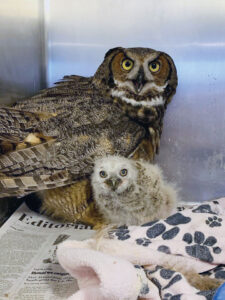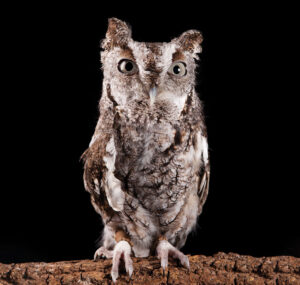
It all started when Adele Moore and then husband Richard Evans spotted an injured cottontail rabbit in the middle of the road in 1972. They took the rabbit to a local veterinarian, who stitched it up and sent it back home with them. In their care, the rabbit quickly recovered, and they released it back into the wild where it belonged.
Hooked, Adele and Richard, who later became a veterinarian, rescued more wild animals to rehabilitate and release. They used their nephew’s treehouse as a nest box for orphaned raccoons. That nest box became the namesake for the 40-year-old animal rescue they founded called TreeHouse Wildlife Center.

“Our mission is to rescue, rehabilitate and release wildlife, and to provide environmental education to the public,” says Kelly Vandersand, fundraising coordinator for TreeHouse Wildlife Center. Because the center is a nonprofit that relies on private donations, grants and programming fees, Kelly writes grants, organizes fundraising events and finds creative ways to help fund care for injured, sick or orphaned wildlife.
TreeHouse Wildlife Center has a small staff of five or six at a time. Kelly has found herself doing animal care, rescues, education programs and more. “I’m very passionate about TreeHouse Wildlife Center, so I’m willing to get my hands dirty and do anything that needs done.” However, she says volunteers keep the center going.
“Our volunteers are the backbone of the organization,” she says. “Staff can only do so much. If we didn’t have volunteers, we would not be able to do what we do.” There are many routes volunteers can take, including landscaping, construction, fundraising, animal rehab and emergency transport.
The transport system allows the center to rescue animals hours away from the facility in Dow, Ill. They’ve had rescues from Peoria, Springfield, Vandalia and as far as Cairo. “We have a huge range,” Kelly says. “We’re one of the only centers in south central Illinois with a transport system. We have animals coming in regularly from 2 to 3 hours away.”
Once an animal is admitted, the workers give it space for the first 15 minutes to help it calm down. “It’s traumatic for them,” Kelly explains. “Even domestic pets get stressed at the vet, but at least they have a connection with people, whereas all [wildlife] know is they’ve been captured, they’re injured, and they don’t know what’s going on. We always give them time before the evaluation.”
Once the animal has been checked for injuries, dehydration and malnourishment, staff begins treatment and develops a care plan. “The animal will spend time in critical care in our clinic. … Once they are done with treatment, they will go out to the rehab buildings, which is the next phase before being released, where they will be reacclimated to being outside.”

Owls will get the opportunity to go back to a nighttime cycle. Birds are released to the flight cage, where they can learn to fly and hunt again. “Since we’ve been feeding them, we’ll have to make sure they are hunting for food because it doesn’t do the animal any good if it isn’t able to care for itself when we release it back to the wild,” Kelly explains.
Mammals will go to an outdoor enclosure, where they will get food and water and have everything necessary for rehabilitation. For example, squirrels must learn to climb trees and dig for their food. “It is a little bit of a different concept for each animal,” Kelly says. “We never just release straight from the clinic. We always have that transitional phase to going back outside.”
However, not all animals can go back to the wild because of their injuries. TreeHouse is a sanctuary for these animals. On M.J.M. Electric Cooperative lines, the facility is located on 8.5 acres that an anonymous foundation helped purchase in 2010. Staff and volunteers are on-site every day for animal care because there are 60 permanent residents in addition to the animals in the hospital and rehab.
In order to help the center survive, it was decided to make it a public, open area where visitors can see and learn more about Illinois’ native animals through the outdoor enclosure facility. The facility is accessible to everyone and guests can visit for free.
“We don’t charge people to visit and walk around the center,” Kelly says. “We developed an education center. We have a small gift shop, and people can stop in every day of the year except Thanksgiving and Christmas. … We figured more education for the public will help improve the lives of wildlife by just learning a little bit about the animals and developing a bond with them. We hope people will take an interest and help ensure wildlife have a better habitat in which to live.”
TreeHouse Wildlife Center is a state and federally licensed facility. The state license covers mammals and the federal license covers birds. “We work with most native species that reside or migrate through Illinois,” Kelly says. While the center gets a lot of owls, hawks and eagles, they do get a few coyotes, foxes and the occasional bobcat, but squirrels and opossums are the most common residents.

“Many people don’t see the value of rehabbing a squirrel, but there are two ways to look at it,” Kelly explains. “Squirrels are the largest planters of a forest. They plant trees like crazy. Then they are prey, so they feed other animals. If you return those animals back to the ecosystem, they may live out their lives perfectly happy, but they may also feed a raptor or coyote.”
She also explains that opossums are great environmental stewards because they eat ticks and don’t carry diseases. “They are a wonderful animal to return back to the environment.” Because of state law, the center can’t take in bats or skunks.
The center has both on- and off-site programming. They go out to schools or scout events to do educational programs, and some of their permanent resident animals are education ambassadors.
“When we make the decision that an animal cannot go back into the wild, we will evaluate it to see how it interacts with people and if it might become a good education ambassador,” Kelly explains.

screech owl is an education ambassador. He was admitted to TreeHouse Wildlife
Center in 2010 after
he was hit by a car.
Photo by Eric Bloemker.
If the animal takes well to being handled and isn’t stressed in public and having people nearby, then it will be trained to be an education ambassador. Kelly says they have some famous ones. Einstein the turkey vulture draws a big crowd, and Buddy, a tiny screech owl, is always a crowd favorite.
“We have five eagles that reside with us,” Kelly says. “They all have permanent wing injuries and can’t go back to the wild. During eagle watching, people get to see these animals in their closure up close. It is one thing to see them flying or in a tree, but when you’re able to get within 20 feet, it is amazing to see how big and powerful these animals are.”
For the permanent residents, the center offers a guardianship program. This program allows people to sponsor an animal for one year, which helps pay for the cost of food, care, shelter and medical treatment. Guardians receive a certificate, the animal’s history and photo, a letter of thanks, and a sign on the animal’s enclosure.
Financially, TreeHouse Wildlife Center relies on private donations, grants and fundraisers, and COVID-19 has impacted the center in many ways. All educational and many fundraising events have been canceled, and because the center has been closed to visitors during the pandemic, the gift shop has been shut down and all of its proceeds go to the rehabilitation program.
“We’re trying to protect our rehab staff as much as possible,” Kelly says. A curbside drop-off has been set up so people can bring in rescues and make donations. “We ask everybody to remain in their cars. If our staff gets sick, we will be in a world of hurt trying to care for our critical patients.”
In hopes to offset lost income, the center applied for grants and started a GoFundMe campaign. “We’re all in the same boat,” Kelly says. “We realize people are suffering too, but we have a commitment. These animals are in our care; some are threatened and endangered species. We can’t just walk away from them.”
As for TreeHouse Wildlife Center, after 40 years, Adele continues to be the executive director, and Kelly says they will continue their mission to save wildlife and hope people will be able to visit soon. “We are still taking rescues and we need donations to help care for all the spring babies.” She explains any donation is appreciated, even a small one. Just $1 will be a meal for an animal.
“Wildlife still matters,” Kelly says. “TreeHouse is the voice of wildlife, and while there are a few centers in the state, there’s not a lot of resources for wildlife. … We try to help as many animals as financially possible.”










